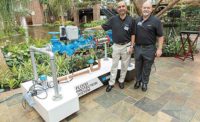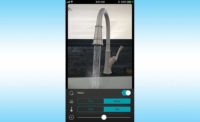Canature WaterGroup has been serving the North American water conditioning industry for more than 50 years. In 1968, WaterGroup was founded by current Canature WaterGroup President and CEO Don Fettes. The Saskatchewan, Canada-based company notes its focus on providing customers with exceptional value — high-quality, innovative products backed with industry-leading support — has allowed it to expand its customer base across North America. Today, Canature has six regional distribution facilities that serve customers in Canada, the U.S., and Mexico. Supply House Times recently chatted with Canature WaterGroup’s John Cardiff, the executive vice president of sales and business development in the U.S., about a variety of topics, including Canature’s continued growth and its short-term plans. Cardiff has 37 years of industry experience, and is responsible for developing Canature’s plumbing and heating wholesale channel in the U.S.
What makes Canature WaterGroup stand out?
JC: One of the biggest differentiators is our business model. We are both a manufacturer and distributor. This gives us the ability to have complete control over the quality of our components, to produce high-quality products at a lower cost and to react quickly to our customer’s needs. It also allows us to develop a highly knowledgeable customer support team. Our staff is all factory-trained and works solely with our products. Our customer service team has an average of 20 years’ experience and we have a dedicated team of engineers on staff in our commercial industrial engineering division.
Where is Canature taking the water treatment space?
JC: Our focus is on developing products that are more efficient, that safely remove emerging contaminants in drinking water and are engineered for specific applications, rather than taking a “one size fits all” approach. One example of our focus on efficiency is our H.E.R.O. system. While conventional R.O. systems send up to 12 liters of water to the drain for every liter of drinking water produced, the H.E.R.O. wastes virtually no water. Our 85HE residential softeners use up to 75% less salt and 64% less regeneration water than traditional conventional calendar clock models. And by taking a totally new approach to commercial softening, our engineers have designed multi-tank water softeners that use up to 50% less salt and 38% less water than conventional single or dual-alternating tank systems.
How is Canature taking its relationships with distributors and dealers to the next level?
JC: Our goal is always to provide our customers with exceptional value, and one of the ways we do that is through personalized customer support. We have the largest field sales team in the industry, which allows our sales managers to work closely with our customers to understand their businesses. Our customer support team has an average of 20 years of industry experience, and each team member is paired with a sales manager so our customers always speak with someone they know. Another value-added service our customers appreciate is our training opportunities. We have a dedicated, in-house team of expert trainers who host webinars on a variety of water treatment topics. When group training works better, we provide full-day, in-person training sessions right at our customers’ businesses.
How is Canature best working with the engineering, design and spec writer community?
JC: Our commercial industrial engineering division (CIED) team is involved in every step of a commercial project. They work directly with engineers and spec writers on product selection and designing the right application for the job, taking time to explain the benefits or pitfalls of certain design choices and common design oversights. We provide professional drawings and spec language documents standard with all quotes. As the job progresses, the CIED team member who helped design the equipment will be the one who supports the contractor through installation and startup, and provides the end-user with technical support regarding troubleshooting and best maintenance practices.
What are the big challenges out there right now when it comes to water treatment in commercial facilities?
JC: One of our biggest challenges is educating the industry on how to look at commercial softening in a new, more efficient way. For decades, commercial softeners have been oversized because their size was based solely on the peak flow rates of a building. While this guarantees that pressure drops won’t be an issue, it doesn’t take into consideration a building’s low flow rates, which can account for 25% of the day, while peak flow rates may never happen, or only happen for a few minutes a day. Our multi-tank commercial softeners (MTS) use Responsive Flow Design to significantly reduce water usage when compared with conventional commercial softeners.
What trends are you seeing in water treatment/filtration?
JC: One trend that has continued to gain traction is the introduction of salt-free residential scale reduction devices. Some of these systems inaccurately market themselves as salt-free softeners, despite the fact they do not truly soften water. In 2018, IAPMPO developed IAPMO/ANSI Z601-2018 for scale reduction devices. According to IAPMO, the standard specifies material safety, structural integrity and minimum performance testing requirements. In the near future, the Water Quality Research Foundation (WQRF) will be publishing a study on the effectiveness of salt-free devices. This will be a study that you’ll want to read.
I think that efficiency is going to become more and more important to consumers, too, particularly as younger adults start buying homes. Systems that needlessly send water or salt to the drain are going to have a difficult time competing against high-efficiency systems.
Why is your distributor-direct program a key differentiator?
JC: Our distributor-direct model gives our customers exceptional value for their dollar. Our team of professional engineers designs all our systems in-house, working closely with our ISO9001:2008-certified manufacturing facility from concept through production. We never have to worry about our customers being affected by a supplier discontinuing a component or making a manufacturing change that isn’t up to our standards. Being distributor-direct also allows us to work closely with both distributors and plumbers to provide value-added services such as free training, marketing programs and water testing.
What does the future hold for Canature?
JC: In the short-term, we are focusing on our expansion into Mexico and continuing to grow our business in the U.S. Our long-term goal is to be a leading global water treatment company.





